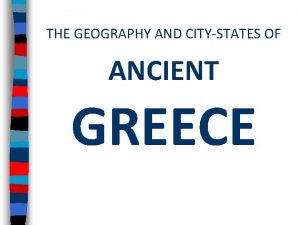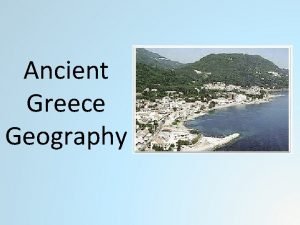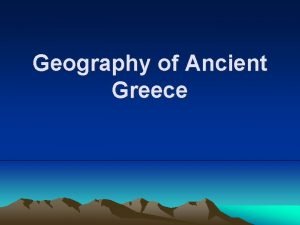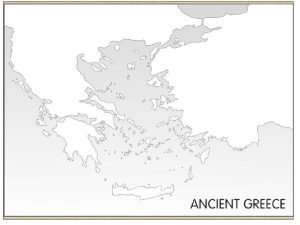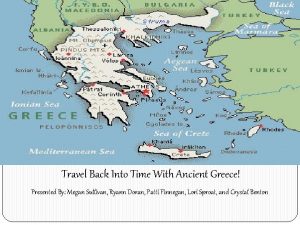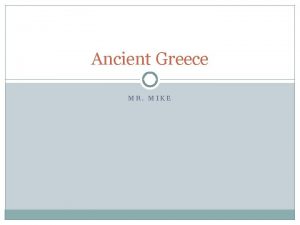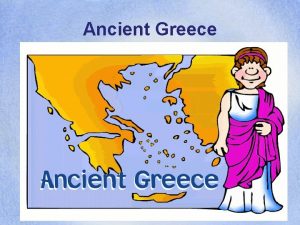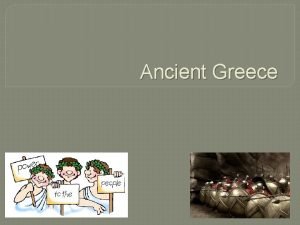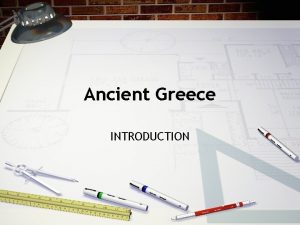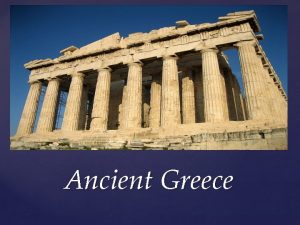THE GEOGRAPHY OF ANCIENT GREECE I can explain







- Slides: 7

THE GEOGRAPHY OF ANCIENT GREECE I can explain how the geography of Greece influenced life of Ancient Greeks.

Geography Shaped the Lives of the Ancient Greeks Greece is a land of many coasts and islands! Therefore it is easy to see that they ate a lot of fish. The inland areas (those areas not along the coast) were, and still are very rocky and arid (which means dry) so farming was difficult. However the Greeks adapted to their environment and learned to grow olive trees and raise sheep for wool. The southern part of Greece forms a peninsula called the Peloponnesus. Between the northern ‘mainland’ and this Peloponnesus Peninsula, a narrow strip of land called an isthmus links the Peloponnesus to the northern half or ‘mainland’ of Greece.

Landscape and Climate Mountains cover 70 to 80 percent of Greece. The mountains and their valleys divided it into many regions. The uneven landscape made transportation over land difficult. Greece had no large rivers on which people could travel or farm. Therefore communication and trying to stay unified, was very difficult for the Greeks. Greece has mild, rainy winters and hot, dry summers; very much like Arizona. In much of Greece, temperatures range from about 50 degrees Fahrenheit in winter to 80 degrees Fahrenheit in summer. The warm climate encouraged outdoor life, as a result outdoor athletic competitions (Olympics!) such as races were an important part of Greek culture.

Agriculture Greek land was rocky, so only about 20 to 30 percent of it was good for farming. Even so, more than half of all Greeks were olive farmers or herders. (Most farmland was located in the valleys between mountains. ) In Greek society, landowners were part of the upper class. In general, only men owned property. A person who owned land could support himself. He had enough wealth to pay for equipment such as helmets, shields, and swords. This allowed him to serve in the army and defend his homeland. As a result, people respected landowners, who had a higher place in society than merchants or poor people. In order to get more useable farmland, the Greeks founded colonies in other regions. The western shores of the Aegean Sea, by Troy had many broad plains and rivers where it was easier to farm. So the Greeks founded many colonies there. The lack of farmland was not the only problem. Greece also lacked natural resources such as precious metals. The Greeks had to find those resources somewhere else. One resource that Greece did have plenty of was stone for building. (Like we already discussed, Greece also had plenty of fish, wool, and olives too. )

Water Routes Helps Greece Prosper Just as rivers influenced other ancient cultures, the sea influenced Greece has a long coastline, and most places in Greece are less than 100 miles from the coast. In fact, many cities were built directly on harbors. Several seas played a major role in the life of ancient Greece. The largest was the Mediterranean Sea to the south. The Ionian Sea (west of the mainland) and Aegean Sea (east of the mainland) were branches or smaller parts of the Mediterranean Sea. These “highways of water” linked most parts of Greece to each other. The Greeks used these seas as transportation routes because sailing a boat was much easier than walking or driving a cart over their rocky, mountainous land.

Types of Ships The Greeks became skilled sailors and shipbuilders. They built rowing ships for fighting and sailing ships for trading or transportation. Sailing ships had a single mast and square sail and did not use rowers unless there was no wind. Fighting ships were huge and had several rows of rowers, several sails and a battering ram front. They were built specifically to move fast, turn quickly and to attack and damage other ships. The Ionian and Aegean Seas are not very large. Small ships could sail around them by staying near the coast or by sailing from island to island. Once the Greeks learned these routes, they could sail to other regions. The sea was a source of fish, an important part of the Greek diet. The Greeks traded fresh fish from the sea to local ports long the coast. The Greeks also dried some kinds of fish so that they could be transported over great distances.

Trade and Commerce Because Greece lacked good farmland, the Greeks did not produce much grain, but they did produce surplus olive oil, olives, wine, wool, and fine pottery. Greek city-states bought and sold surplus goods from each other. In addition, they traded these items to other regions around the Black Sea and the Mediterranean Sea, including Egyptians. The main products that the Greeks bought (because it was lacking in their land) was grain, timber for building, animal hides, and slaves. The Greeks also traded for nuts, figs, cheese, and flax, which was used to make linen for clothing. http: //safeshare. tv/w/xxesh. XALh. J
